
Miten Islantiin kannattaa pukeutua? Täydellinen pukeutumisopas vuodenaikoihin

- Puhutaan kerrospukeutumisesta
- Aluskerros
- Välikerros
- Ulkokerros
- Miten pukeutua Islannissa keväällä
- Sää keväällä (huhti–toukokuu)
- Mitä vaatteita pakata Islantiin keväällä
- Miten pukeutua Islannissa kesällä
- Sää kesällä (kesä–elokuu)
- Mitä vaatteita pakata Islantiin kesällä
- Miten pukeutua Islannissa syksyllä
- Sää syksyllä (syys–lokakuu)
- Mitä vaatteita pakata Islantiin syksyllä
- Miten pukeutua Islannissa talvella
- Sää talvella (marras–maaliskuu)
- Mitä vaatteita pakata Islantiin talvella
- Millainen uimapuku kannattaa pakata Islantiin
- Mitä ei kannata pukea Islannin nähtävyyksiin tutustuessa
- Mitä pukea kaupungille
- Pukukoodit Islannissa
- Vaatteiden ostaminen Islannissa
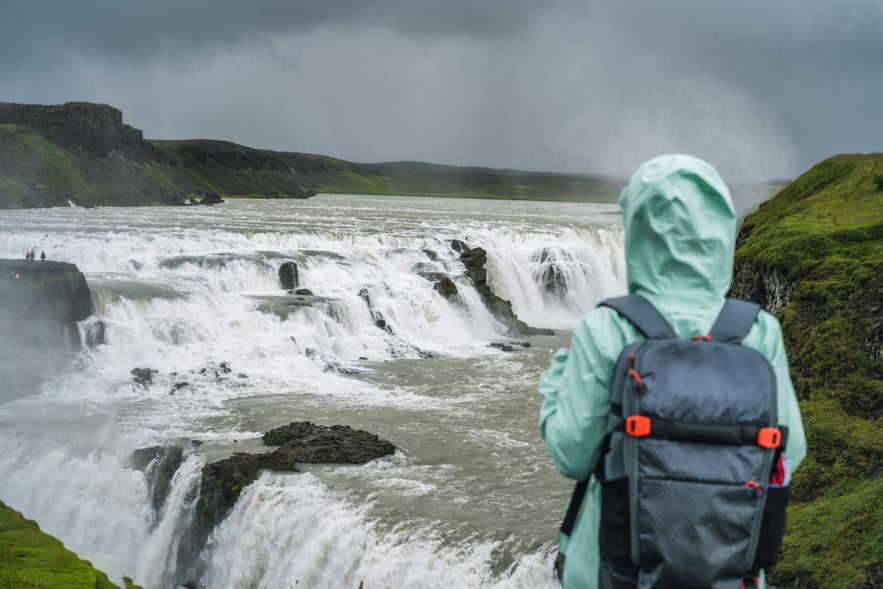
Aurinkoinen taivas, sadekuuro, kova tuulenpuuska ja yllättävä lumisade. Tämä ei ole kuvaus neljästä vuodenajasta, vaan mahdollinen kuvaus yhden päivän säästä Islannissa. Älä vielä ala panikoimaan pakkaamisen suhteen, sillä hyvä valmistelu on kaiken a ja o.
Kaikkeen kannattaa varautua, nautitpa sitten revontulien hehkusta revontuliretkillä, paistattelit auringossa kesäretkillä tai uhmaat kylmää talvimatkoilla. Tämä täydellinen opas Islantiin pukeutumiseen tarjoaa sinulle kattavasti tietoa pysyäksesi lämpimänä käydessäsi Islannissa, milloin tahansa ympäri vuoden.
Vaikka sää on varmasti arvaamaton vuodenajasta riippumatta, Islantiin suuntautuvan matkan suunnittelussa on hyviä puolia, varsinkin jos suunnittelet omatoimista automatkaa vuokra-autolla matkaa kuuluisalle rengastielle. Koska talvet ovat suhteellisen leutoja ja kesät viileitä, lämpötilan vaihtelu Islannissa ei ole aivan niin suuri kuin voisi odottaa. Tietenkin joitakin muutoksia vaatetuksen suhteen teet riippuen siitä, milloin päätät vierailla Islannissa, mutta jotkin pukeutumisperiaatteet pätevät vuodenajasta toiseen.
Puhutaan kerrospukeutumisesta

Vuodenajasta riippumatta, kerrospukeutumisen tärkyes on tärkeää muistaa Islantiin valmistautuessa. Tämä pukeutumisstrategia tarkoittaa, että jokaisella kerroksella on erityinen tehtävä, ja koko pukeutumisjärjestelmä toimii yhdessä yhtenä kokonaisuutena tarjoten mukavuutta ja suojaa monenlaisissa sääolosuhteissa. Kuulostaa melko kätevältä Islantiin, eikö vain?
Olitpa ajatellut sitä tai et, olet käyttänyt vaatteitasi kerroksittain ennenkin. Kerrosvaatetuksen käyttäminen on Islannissa avainasemassa säähän ja erämaan arvaamattomuuteen varautuessa, joten käydään nopeasti läpi jokainen kerros järjestyksessä:
Aluskerros
Tämä kerros on suorassa kosketuksessa ihosi kanssa ja siihen kuuluvat esimerkiksi alusvaatteet, pitkähihaiset paidat, t-paidat ja sukat. Sen ensisijainen tehtävä on hallita kosteutta ja siirtää hikeä pois kehosta pitääkseen sinut kuivana. Tämä auttaa säätelemään kehosi lämpötilaa ja estämään liian nopean jäähtymisen kylmissä olosuhteissa. Synteettiset tekstiilit tai villa ovat hyviä valintoja, mutta vältä puuvillaa, koska se imee kosteutta ja voi saada sinut tuntemaan olosi kylmäksi ja märkäksi.
Välikerros
Välikerroksen ensisijainen tehtävä on eristää ja säilyttää kehon lämpöä pitääkseen sinut lämpimänä. Se vangitsee ilmaa lähellä kehoasi, jota kehon lämpö lämmittää ja suojaa kylmältä. Hyvä välikerros voisi olla fleecetakki, softshell-takki tai villapaita. Talvella on myös hyvä idea pukea paksummat sukat pohjakerrossukkien päälle.
Ulkokerros
Ulkokerros on suojasi tuulelta, sateelta tai lumelta. Tämän kerroksen vaatetukseen kuuluvat esimerkiksi kovakuoriset takit ja vedenpitävät housut. Tämän kerroksen tulee olla joko vedenpitävä tai suurimmaksi osaksi vedenpitävä ja usein myös tuulenpitävä. Parhaat ulkokerrokset ovat myös hengittäviä, jolloin hien kosteus pääsee poistumaan, joten et tunne oloasi märäksi ja kosteaksi.
Miten pukeutua Islannissa keväällä
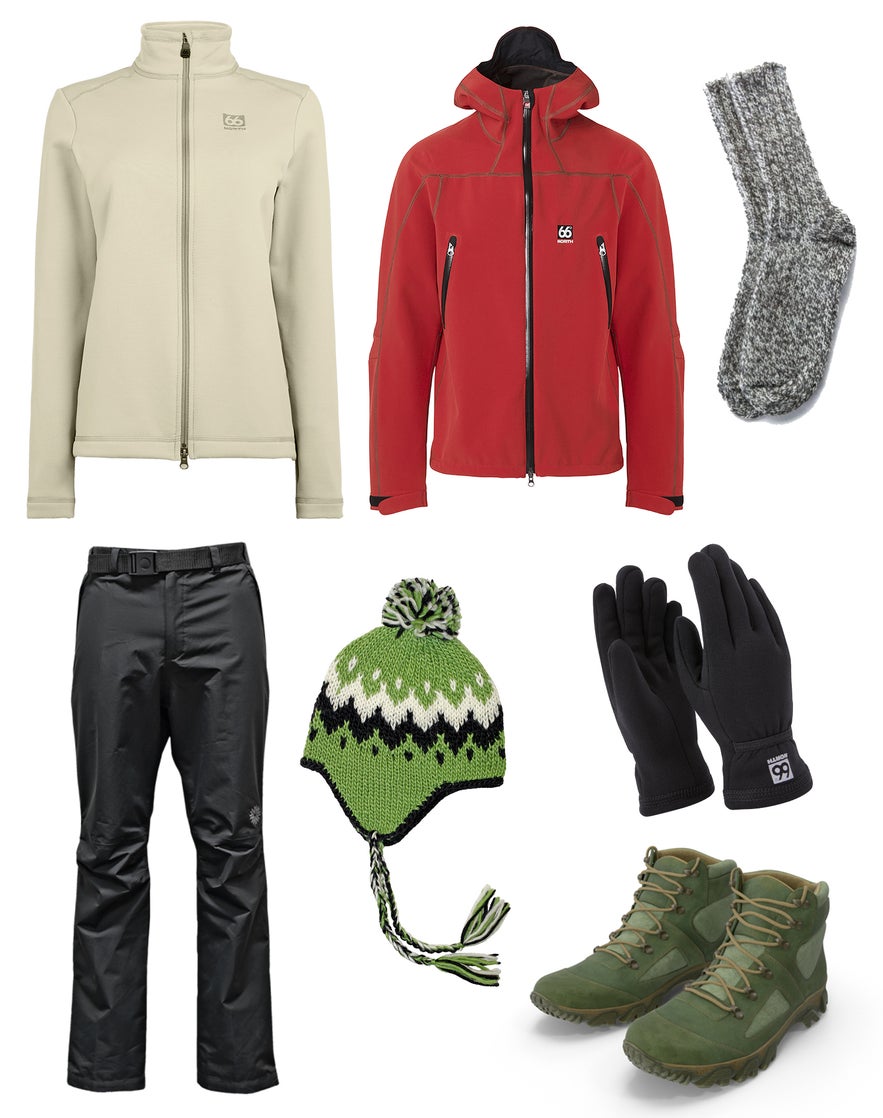 Vilkas kevät Islannissa alkaa tuoda mukanaan leudompaa säätä. Tai no, leudompaa ainakin Islannin standardien mukaan. Päivät pidentyvät ja tietyt muuttolintulajit palaavat Islannin rannoille.
Vilkas kevät Islannissa alkaa tuoda mukanaan leudompaa säätä. Tai no, leudompaa ainakin Islannin standardien mukaan. Päivät pidentyvät ja tietyt muuttolintulajit palaavat Islannin rannoille.
Sää keväällä (huhti–toukokuu)
Islannin kevään keskilämpötilat vaihtelevat yleensä noin 0–7 °C välillä huhtikuussa ja 4–10 °C välillä toukokuussa. Tuulisia olosuhteita on odotettavissa etenkin rannikkoalueilla ja ylängöillä.
Sade on melko yleistä huhti- ja toukokuussa, vaikkakin tyypillisesti kevyempää kuin muina kuukausina. Vaikka se on harvinaista, lumisade on todellinen mahdollisuus keväällä Islannissa.
Mitä vaatteita pakata Islantiin keväällä

Keväällä Islantiin pakattaessa kannattaa toivoa parasta, mutta varautua pahimpaan. Vaikka sää on yleensä leuto, kannattaa pakata ikään kuin kohtaisit melko paljon tuulta, sadetta ja mahdollisesti lunta.
Ole valmis kohtaamaan sekä kylmempi ja lämpimämpi sään, joten kunnollinen lämpökerros on ratkaisevan tärkeä. Väli- ja ulkokerroksille suosittelemme fleecepuseroita ja tuulitakkia. Shortsit ja t-paita on hyvä ottaa mukaan, jos sää lämpenee.
Retkeilykengät tai tukevat kävelykengät ovat välttämättömiä epätasaisessa maastossa, sekä suojaamaan jalkojasi sääolosuhteilta. Mukaan kannattaa ottaa myös lämmin hattu, paksut käsineet ja huivi suojaamaan mahdolliselta kylmyydeltä.
Muista, että on parempi tulla yli- kuin alivalmistautuneena. Kerrospukeutumisen kauneus piilee siinä, että voit lisätä tai poistaa kerroksia tarpeen mukaan.
- Lue lisää: Kevät Islannissa – Kattava matkaopas
Miten pukeutua Islannissa kesällä
 Kesä on Islannin matkailun vilkkain kausi, monen turistin pakkautuessa maahan nauttimaan lämpimämmistä säästä ja hyödyntämään keskiyön auringon tarjoamia pidempiä päiviä.
Kesä on Islannin matkailun vilkkain kausi, monen turistin pakkautuessa maahan nauttimaan lämpimämmistä säästä ja hyödyntämään keskiyön auringon tarjoamia pidempiä päiviä.
Sää kesällä (kesä–elokuu)
Ei ole yllättävää, että kesä on Islannin lämpimin vuodenaika. Keskimääräiset lämpötilat näinä kuukausina vaihtelevat tyypillisesti 9–15 °C välillä, ja lämpimin sää on heinäkuussa. Lämpimmät päivät eivät ole harvinaisia, joskus mittari kirpoaa yli 20 °C, joskus jopa hieman ylemmäksikin.
Kesällä sade on melko yleistä, mutta sateet ovat yleensä lieviä ja menevät ohi nopeasti. Vaikka Islanti on aina tuulinen, tuulet ovat kesällä yleensä rauhallisemmat kuin muina vuodenaikoina.
Mitä vaatteita pakata Islantiin kesällä

Vaikka Islannin kesä on lämpimämpi kuin muina vuodenaikoina, sinun ei kannata tulla Islantiin Crocseihin pukeutuneena ja odottaa trooppista paratiisia — Islanti on kesälläkin melko viileä verrattuna useimpiin kesäkohteisiin.
Pakkaa hyvä pohjakerros mukaasi pysyäksesi kuivana, sekä lyhyt- että pitkähihaisia paitoja säästä riippuen. Heitä mukaan toppeja, jos haluat heittäytyä villiksi. Jälleen, hyvä välikerros lämmöneristykseen, kuten fleece- tai villapaita, käy hyvin. Veden- ja tuulenpitävä ulkokerros on tärkeä, jos matkustat erämaahan. Voit vapaasti riisua joitakin kerroksia, jos tunnet itsesi ylipukeutuneeksi erityisen kuumana päivänä.
Kannattaa myös pakata mukaan kevyempiä vaatteita lämpimiä päiviä varten, varsinkin jos aiot viettää muutaman päivän kaupungissa. Shortsit, aurinkomekot ja vapaa-ajan kengät tekevät kaupunkireissusta aurinkoisena päivänä paljon nautinnollisemman kuin vaellusvarusteisiin tälläytyminen. Aurinkolasit ja silmänaamio keskikesän aurinkoon ovat hyödyllisiä.
- Katso lisää: Kesä Islannissa – Täydellinen matkaopas
Miten pukeutua Islannissa syksyllä
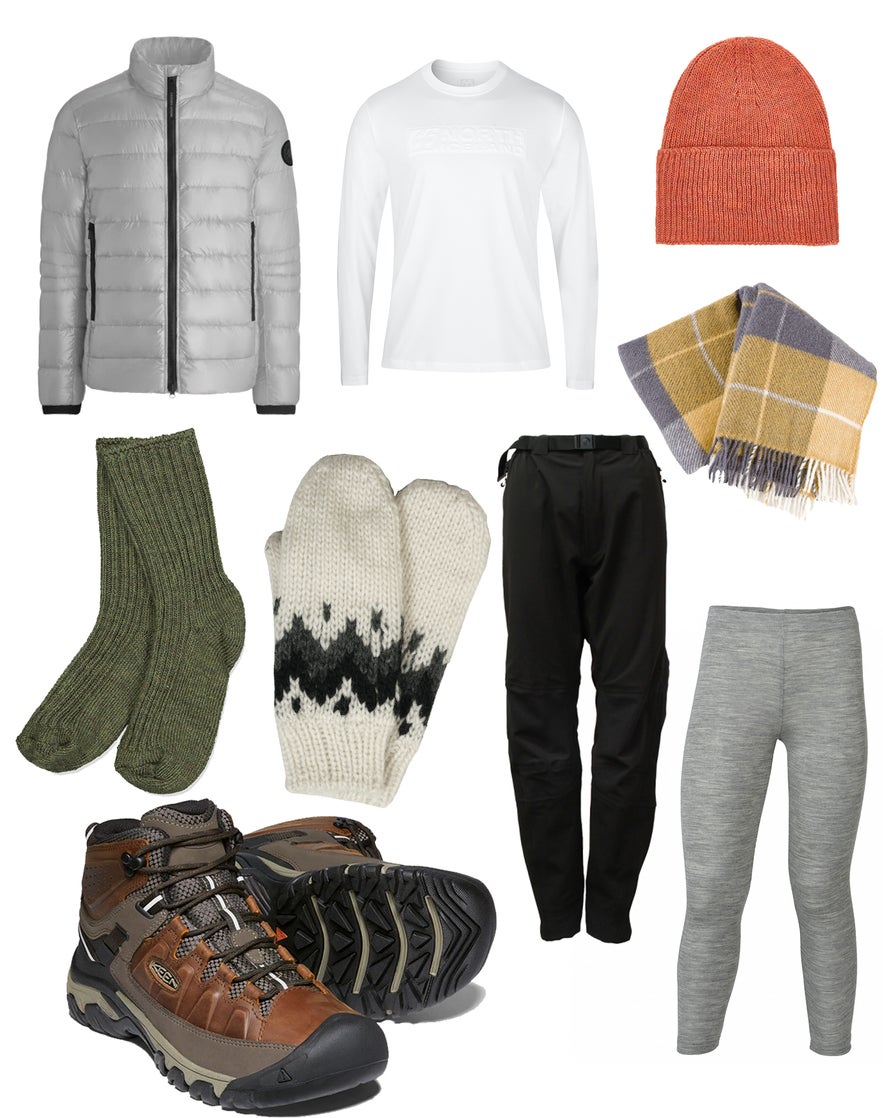 Syksyn saapuessa päivät Islannissa lyhenevät ja syksyn värit peittävät maan. Syksy on erinomaista vuodenaikaa revontulia kaipaaville vierailijoille ja niille, jotka haluavat pistää sadevaatteensa tositestiin.
Syksyn saapuessa päivät Islannissa lyhenevät ja syksyn värit peittävät maan. Syksy on erinomaista vuodenaikaa revontulia kaipaaville vierailijoille ja niille, jotka haluavat pistää sadevaatteensa tositestiin.
Sää syksyllä (syys–lokakuu)
Sään viiletessä syksyllä, voit odottaa syyskuun keskilämpötilan pysyttelevän noin 7–13 °C ja alimmillaan noin 2 °C ja 7 °C lokakuussa. Lämpötilat vaihtelevat jonkin verran, ja kylmemmät säät ovat yleisiä.
Tuulet alkavat voimistua syyskuukausina, ja voit odottaa sadetta ja mahdollisesti lunta. Jos matkustat Pohjois-Islantiin tai ylängöille, ole erityisen tarkkana pakkaamisen suhteen valmistautuessasi matkaasi.
Mitä vaatteita pakata Islantiin syksyllä

Pakkaa jälleen lämpöinen pohjakerros pysyäksesi kuivana ja tukeva välikerros — kuten lämmin villapaita tai fleece — pysyäksesi lämpimänä. Tuulitakki tai sadetakki on välttämätön ulkokerrosvalinta äkillisiä sadekuuroja tai tuulenpuuskia vastaan syksyllä. Myös sadehousujen ja sadeponchon pakkaaminen reppuun on hyvä idea.
Saattaisi luulla, että sateenvarjo olisi toimiva ratkaisu Islannin syyssateisiin, mutta todellisuus on, että voimakkaat tuulet todennäköisesti vievät sen mukanaan. Suosittelemme keskittymään sen sijaan vedenpitävään ulkokerrokseen. Hatut, käsineet ja lämmin pipo ovat myös välttämättömiä suojaamaan kylmältä, mutta varmista, että ne eivät ime liikaa kosteutta.
- Katso lisää: Islanti syksyllä — Täydellinen matkaopas
Miten pukeutua Islannissa talvella
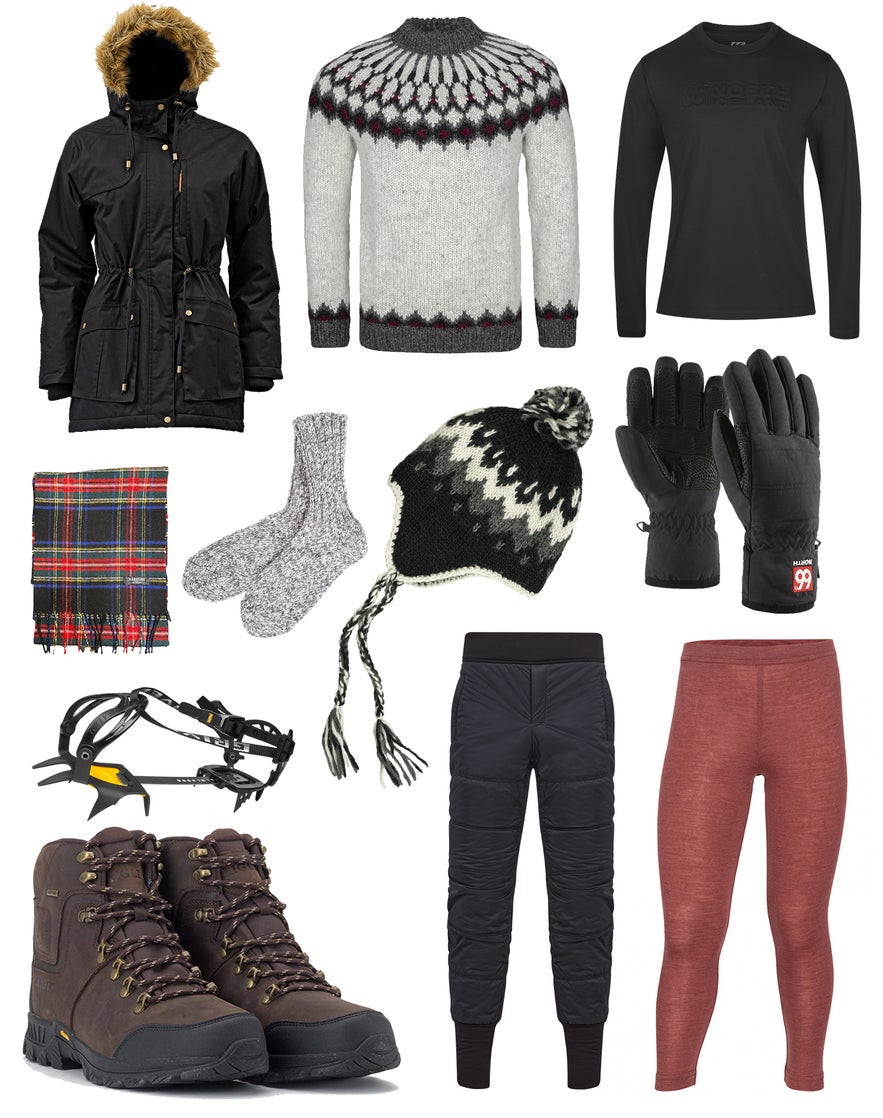 Talvi on luonnollisesti Islannin kylmin vuodenaika, mutta se on myös otollisinta aikaa revontulien bongaamiseen. Vaikka sääolosuhteet voivat olla kylmähköt, hyvin valmistautuneet matkailijat palkitaan kauniilla, lumisilla maisemilla.
Talvi on luonnollisesti Islannin kylmin vuodenaika, mutta se on myös otollisinta aikaa revontulien bongaamiseen. Vaikka sääolosuhteet voivat olla kylmähköt, hyvin valmistautuneet matkailijat palkitaan kauniilla, lumisilla maisemilla.
Sää talvella (marras–maaliskuu)
Talvi Islannissa on Islannin pisin ja kylmin vuodenaika, jolle on ominaista kylmät, pakkasen puolelle laskevat lämpötilat. Marraskuussa keskilämpötilat vaihtelevat –1 °C ja 4 °C välillä, ja – 5 °C ja 2 °C välillä joulukuussa.
Tammi- ja helmikuu ovat Islannin kylmimmät kuukaudet, ja keskilämpötilat vaihtelevat välillä –10 °C ja 3 °C. Maaliskuussa säät alkavat lämmetä hieman, ja lämpötilat vaihtelevat välillä – 2 °C ja 3 °C.
Lumisateet ovat yleisiä talvella, erityisesti maan pohjois- ja itäosissa sekä ylängöillä, joihin ei pääse kauden aikana. Jäätä on monesti teillä ja kävelyteillä. Islannissa saattaa esiintyä myrskyjä, jolloin tuulee voimakkaasti, ja tuulen viiman vuoksi lämpötila saattaa tuntua jopa kylmemmältä.
Mitä vaatteita pakata Islantiin talvella

Matkustaessasi Islantiin talvella, varaudu talvisiin ulko-olosuhteisiin huolellisesti. Pakkaa mukaan kosteutta siirtävä pohjakerros, kuten villaiset alusvaatteet — etenkin pitkät alushousut kannattaa ottaa mukaan.
Lisää eristävä välikerros, kuten fleeceä tai villaa, ja pakkaa tavallisten sukkien päälle paksummat sukat pitääksesi jalkasi lämpiminä. Ulkokerrosta valittaessa suosittelemme paksua, eristävää parka- tai untuvatakkia. Veden- tai tuulenpitävät housut tekevät matkastasi huomattavasti mukavamman. Jos valitset kevyemmän ulkokerroksen, varmista, että keskikerros on eristävä.
Myös eristetyt, vedenpitävät vaelluskengät ovat välttämätön valinta talviseen Islantiin, ja varmista, että niisssä on hyvä pito jäisiin olosuhteisiin. Jos ei, liukuesteet ovat voittajan valinta. Jälleen, älä unohda lämmintä hattua, paksuja, lämpöeristäviä hanskoja tai lapasia ja huivia tai kaulahuivia, joka suojaa tuulelta.
Katso lisää: Islanti talvella — Täydellinen matkaopas
Millainen uimapuku kannattaa pakata Islantiin
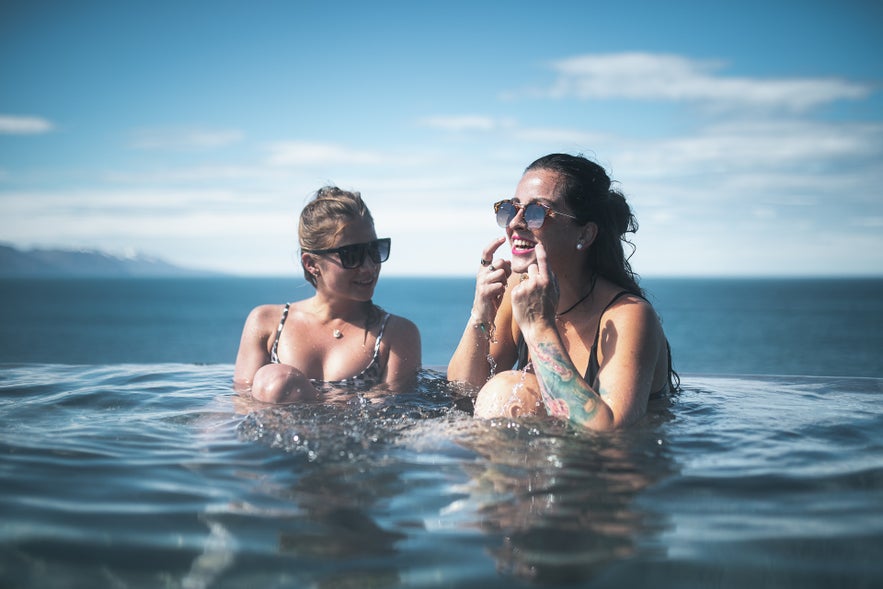
Vuodenajasta riippumatta, uima-asu tulee ehdottomasti pakata mukaan, jotta voit nauttia matkasi aikana Islannin monista kuumista lähteistä ja geotermisistä uima-altaista. Valitse mikä tahansa uima-asu, jossa tunnet itsesi kotoisaksi, olipa kyseessä sitten perinteinen yksiosainen uimapuku, bikinit, uimahousut tai -shortsit.
Et tarvitse varvastossuja tai vedenpitäviä sandaaleita Islannin uima-altaissa tai kuumissa lähteissä, mutta voit ottaa ne mukaan, jos haluat. Nopeasti kuivuva pyyhe on kätevä uima-altaan äärellä, varsinkin talven jäisissä säissä.
Jos et halua pakata uima-asua tai pyyhettä mukaan tai unohdit ne, monet uimapaikat tarjoavat vuokravaihtoehtoja, mutta valikoiman tarjonta ei todennäköisesti ole yhtä tyylikäs tai mukava kuin omasi kotona. Joissakin paikoissa voit myös pulahtaa nakuna, mutta varmista, että se on soveliasta ennen kuin hyppäät veteen ilman rihman kiertämää!
Mitä ei kannata pukea Islannin nähtävyyksiin tutustuessa
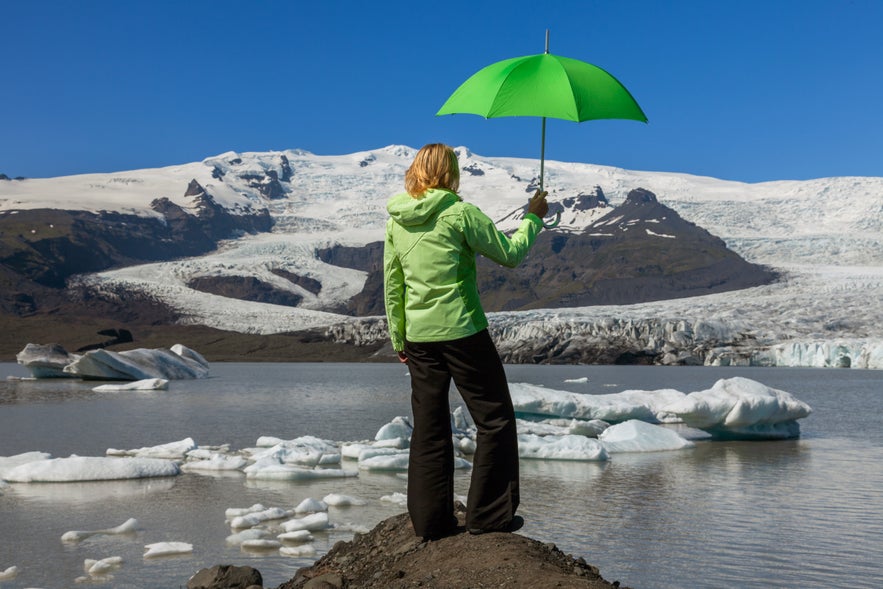 Kun olet miettinyt pukeutumista, tässä muutama asia, jotka voit jättää turvallisesti kotiin.
Kun olet miettinyt pukeutumista, tässä muutama asia, jotka voit jättää turvallisesti kotiin.
Denim- tai puuvillakankaiset ulkovaatteet: Vaikka nämä materiaalit voivat olla sopivia kuiviin olosuhteisiin, ne imevät vettä ja tunnet olosi lähinnä märäksi ja kosteaksi sateisella säällä. Valitse sen sijaan vedenpitäviä tai nopeasti kuivuvia materiaaleja ulkovaatteisiin. Kaupungissa oleskeluun denim tai puuvilla soveltuu kuitenkin hyvin.
Liukkaat tai epämukavat kengät: Islannin maasto voi olla haastavakulkuinen, joten on tärkeää käyttää tukevia kenkiä, joissa on hyvä pito liukastumisen estämiseksi ja kunnollinen nilkkatuki pitkien kävelylenkkien tai vaellusten aikana.
Korkokengät tai pukukengät: Ellei aio viettää paljon aikaa muodollisissa olosuhteissa, korkokengät ja pukukengät ovat epäkäytännöllisiä Islannin maastoon ja säähän, sekä tietysti soveltumattomia jäätiköllä vaeltamiseen Islannissa!
Sateenvarjot: Islannin tuulisessa säästä sateenvarjosta voi olla enemmän haittaa kuin hyötyä. Valitse mukaan vedenpitävä takki ja hattu sateenvarjon sijaan.
Mitä pukea kaupungille

Vaikka et ole millään tavalla turvassa Islannin alati muuttuvilta sääolosuhteilta kaupungissa, voi kaupungille pukeutua hieman rennommin kerrospukeutumisesta poiketen. Erämaahan soveltumattomat vaatteet, kuten farkut tai puuvillapuserot, käyvät kuitenkin mainiosti kaupungille — ja voit pukea jalkaasi myös suosikkitennarisi, kun kadut eivät ole jäässä.
Yllä olevassa oppaassa kuvatut päällysvaatteet sopivat täydellisesti Islannin kaupunkeihin tutustumiseen, mutta värikkäällä tuulitakilla erotut taatusti paikallisten joukosta. Jos et halua näyttää turistilta, harkitse takin vaihtamista rennompaan ja tyylikkäämpään.
Iltaisin ulkona liikkuessa Islannissa voi olla melko viileää. Olipa tilaisuus kuinka muodollinen tahansa, aseta itsesi lämpimänä pitäminen prioriteetiksesi, sillä saatat joutua kävelemään tai odottamaan kylmässä jonkin aikaa riippuen siitä, mitä olet tekemässä. Monissa sisätiloissa on vaateripustimet tai vaatehuoneet, joten sinun ei tarvitse raahata parkatakkiasi pitkin tanssilattioita.
Pukukoodit Islannissa

Yleisesti ottaen islantilaisten ravintoloiden pukeutumiskoodi on melko rento. Useimmat paikat eivät vaadi muodollista pukeutumista, mutta jos et halua erottua joukosta, epävirallinen pukeutumiskoodi on yleensä enemmän "smart casual" kuin tiukasti muodollinen.
Mitä tulee klubeihin ja baareihin, useimmilla niistä ei ole sääntöjä vaatetuksen suhteen. Joillakin Reykjavikin huippuluokan baareilla ja klubeilla saattaa olla hieman tyylikkäämpiä pukeutumisodotuksia, etenkin viikonloppuisin, mutta pukeutumiskoodi on huomattavasti rennompi verrattuna moniin muihin maihin. Yleinen sääntö harvoille klubeille, joilla on pukukoodit on kutakuinkin ei huppareita, neulepuseroita tai verkkahousuja, vaellusasuja, urheilupaitoja tai tennareita.
Nyrkkisääntönä on, että jos olet epävarma, on aina turvallisempaa nojata tyylikkääseen rentoon lookiin kuin liian muodolliseen. Farkut, toppi tai paita sopivat vallan mainiosti useampiin paikkoihin. Jos haluat käyttää puvuntakkia, harkitse sen käyttämistä paksumman ulkotakin alla kylmällä säällä.
Vaatteiden ostaminen Islannissa
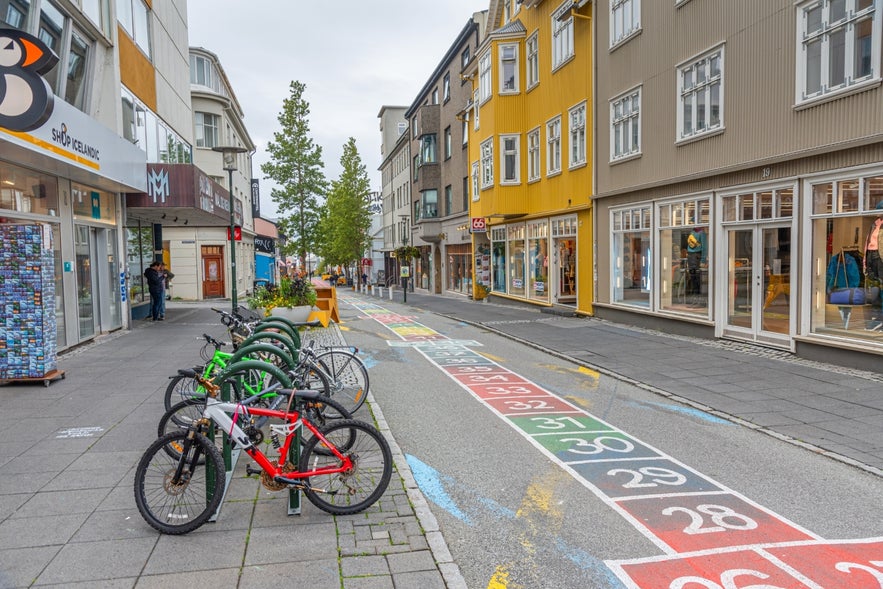
Jos unohdit pakata vaatetusta Islannin-matkaasi varten tai haluat napata mukaasi kotiinviemisiksi yhden Islannin perinteisistä villapaidoista, löytyy vaateshoppailuun useampi vaihtoehto.
Laugavegur on Reykjavikin pääostoskatu. Sieltä löytyy runsaasti vaatekauppoja, kaipasitpa sitten huippuluokan vaellusvarusteita, kirppislöytyöjä tai tyylikkään mekon illanviettoon. Jos oleskelet keskustassa, tämä on luultavasti paras vaihtoehtosi, äläkä pelkää tutustua sivukatuihin!
Kringlan ja Smaralind ovat Reykjavikin alueen suurimmat ostoskeskukset, joissa on useita suurempia vaateliikkeitä (ja paljon ravintoloita, jotka pitävät sinut virkeänä shoppaillessasi).
Kolaportid-kirpputori on loistava paikka löytää kätkettyjä helmiä, joita et löydä vähittäiskaupoista. Avoinna vain viikonloppuisin. Muista, että suurin osa Kolaportidin myyjistä ottaa vastaan mieluummin käteisestä, kun taas muutama hyväksyy myös kortit.
Tämä tiivistää suosituksemme Islannin matkalle pukeutumisesta! Missasimmeko jotain oleellista? Onko sinulla vaatetukseen liittyviä seikkailutarinoita Islannin matkaltasi? Kerro meille alla olevissa kommenteissa!
Muita kiinnostavia artikkeleja

Guide to Icelandin VIP Club: Täydellinen opas
Jos olet Guide to Icelandin asiakas, saat pääsyn Islannin suurimman retki-, majoitus- ja vuokra-autovalikoiman lisäksi myös upeisiin alennuksiin ja erikoistarjouksiin eri paikkoihin ympäri Islantia,...Lue lisää
Islannin Kultainen kierros – täydellinen opas
Lue kaikki, mitä sinun pitää tietää, jos suunnitelmissasi on tehdä Islannin Kultainen kierros. Tutustu upeisiin luonnonnähtävyyksiin, kuten suihkuaviin geysireihin, jyliseviin vesiputouksiin ja kuul...Lue lisää
Islannin parhaat matkanjärjestäjät | Varaa huippuluokan opastettu retki
Löydä Islannin parhaat matkanjärjestäjät ja niiden mielenkiintoisimmat matkapaketit kiertoajeluista seikkailuelämyksiin. Lue artikkelimme, niin tiedät, mihin kannattaa kiinnittää huomiota matkanjärj...Lue lisää

Lataa puhelimeesi Islannin suurin matkailumarkkinapaikka, jotta voit hallita koko matkaasi yhdessä paikassa
Skannaa tämä QR-koodi puhelimesi kameralla ja paina näkyviin tulevaa linkkiä lisätäksesi Islannin suurimman matkailumarkkinapaikan taskuusi. Lisää puhelinnumerosi tai sähköpostiosoitteesi, niin saat tekstiviestin tai sähköpostin, jossa on latauslinkki.




















